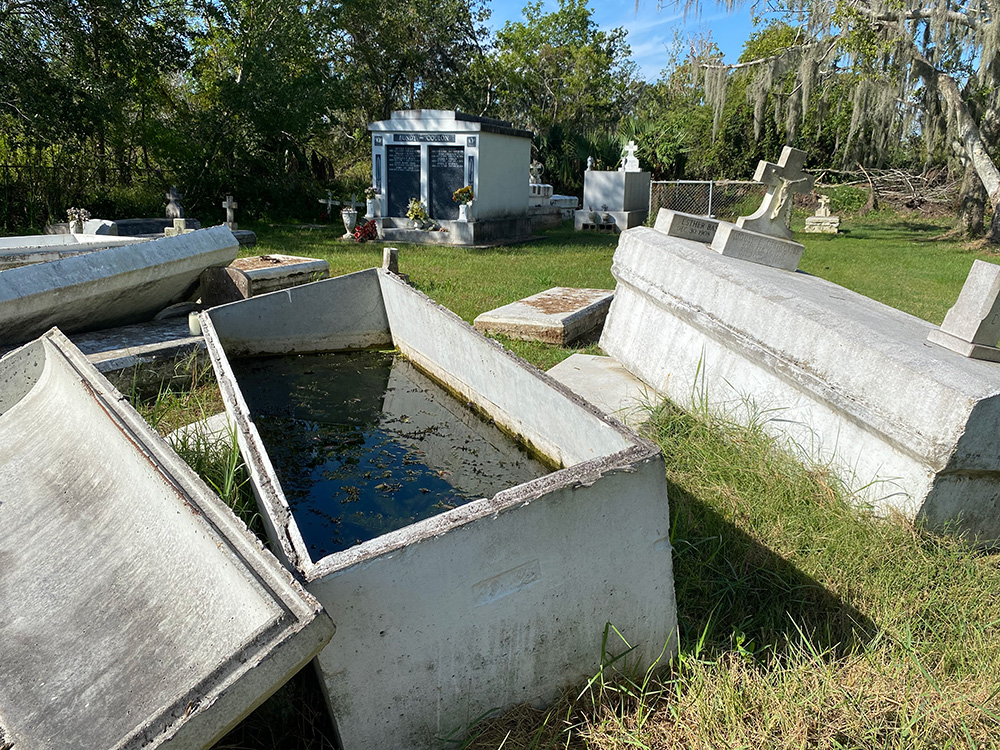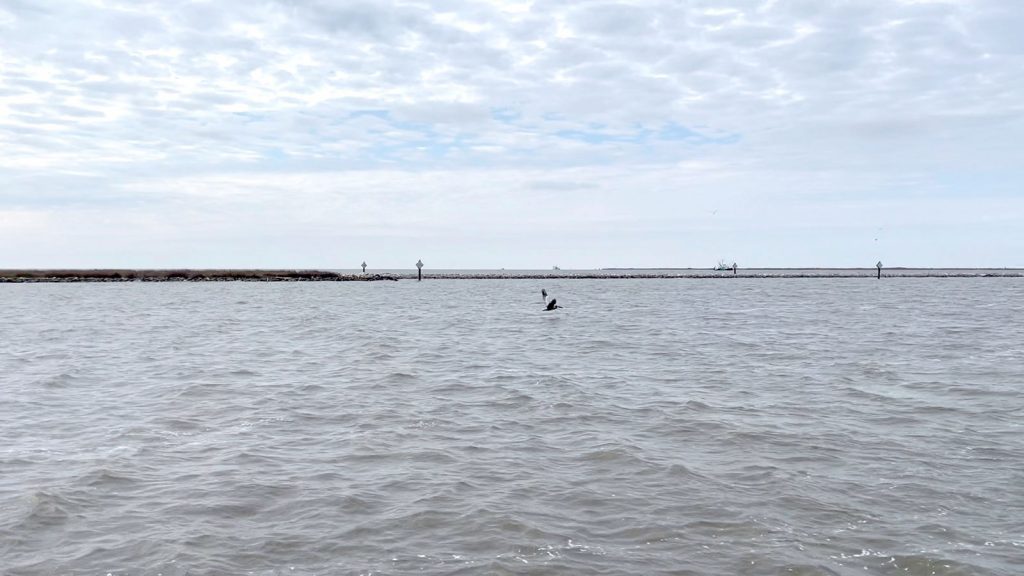Ida Debris Becomes Landscape

By Aaron Galmiche, Photo Editor All across Louisiana’s Bayou region, communities are still hard at work returning their homes and towns to the way things were before Hurricane Ida struck. However, despite the constant recovery, some of this damage and debris has remained for one reason or another and taken on a new role; as a sort of landmark to the very same towns that want them gone or fixed. Kerner Bridge Cemeteries Floating Trailer Blue House St. Anthony Church Dump Site Previous Next Kerner Bridge Remains In the town of Lafitte, the Kerner Swing Bridge, which is the only way in and out of the town of Barataria, has been given a more noticeable, but slightly grim appearance by the effect of hurricane Ida. According to Jefferson Parish officials, the storm caused a barge to break loose and strike the bridge, damaging it and rendering it unsafe for use. The bridge has since been dismantled and replaced by a temporary immovable bridge. Today, it is almost impossible to miss the turn off to Barataria, as the skeleton of the former bridge now stands in a previously open field beside its replacement. A recent visitor to Barataria, Alexis Pellegrin, noted that her family used “the cut up bridge” as a landmark when giving directions around the area. Previous Next Road-side Cemeteries Across Lafitte and Barataria, small family grave sites line many of the towns main roads. These sites have been brought more into the public eye as the effects of Hurricane Ida have left many of the graves tilted, opened, or moved so far from their original resting place that they had to be marked to keep track of where they belong. Signs posted around these gravesites suggest that families are awaiting funding from FEMA to restore these sites to their rightful condition. Until then, these once commonly glossed over sites now grab more attention as Lafitte visitor Alexis Pellegrin notes “You can’t just drive past them and not take a moment to think about those families.” Previous Next The Floating Trailer Just off of Baratarias main road, floating halfway between the Kerner bridge and the road’s end, this trailer has become a landmark to the area surrounding it. Tyler Dufort, a frequent visitor to Barataria, says that he now recognises the roads of the surrounding subdivision, not by their names, but by how many streets they are before or after the trailer . Previous Next blue House This house, which was formerly only noticeable for its blue paint and position at the end of Barataria’s main road, has now become a very recognizable sight in both Lafitte and Barataria. As frequent visitor Tyler Dufort put it, “The only time you’d notice it was when you realized you missed your turn and went too far” Nowadays the house is recognizable from the Barataria side of the river for the windowed view it gives across the river, while the Lafitte side can see the house, beaten but still standing at the end of Barataria, from the town’s handicap fishing pier. Previous Next old st. anthony church Just over the bridge into Barataria, what was formerly the closed and often overlooked St. Anthony church now stands out for its sharp contrast to the area around it, thanks to its new surroundings of black screened fencing and shipping trailers. According to Fonnie Galmiche, a photographer who visited Lafitte shortly after the storm, in the days following Hurricane Ida, many of the heavily displaced graves were gathered around the old church. Later, trailers were moved onto the church grounds for caskets to be held until they could be properly returned. Nowadays, getting to many of the places in Barataria is no longer “Across the bridge and left at the old church” but rather “take a left past the shipping containers” according to Lafitte visitor Alexis Pellegrin. Previous Next dump site Nestled just behind the hub of Lafitte, this “temporary dump site” that was established to help with clearing debris following Hurricane Ida, has become a permanent fixture among the people of Lafitte. Just behind the town’s church and civic center, these brightly colored bins are hard to miss while experiencing the town of Lafitte.
The Lost Bayou: Ida, One Year Later

By Alexis Casnave, Features Editor It’s been one year since Hurricane Ida changed the lives of those living in the Bayou Region of Southeast Louisiana; and while progress has been made, the rebuilding is not over. “As bad as this was and as harmful as it was to our homes and businesses, we are still here,” says Archie Chaisson, Lafourche Parish president. “There’s nothing that truly is not going to come back in some way shape or form, it’s just the time it will take for these things to come back that’s a cause for concern.” “As bad as this was and as harmful as it was to our homes and businesses, we are still here.” — Archie Chaisson, Lafourche Parish president One of the areas that is slow to come back is housing, from fixing damaged structures to rebuilding destroyed homes, especially for South Lafourche, where Ida hit first and hardest. “The South Lafourche community was completely devastated,” Chiasson says. “People are still dealing with insurance claims and insurance companies going bankrupt.” As FEMA and state sheltering programs come to an end, people who are still displaced are struggling to find housing. Fortunately, some residents are slowly getting back in their homes. Joushua Scioneaux, a Cut Off resident, says his parents just moved back into their home after living in a camper for almost a year. “It was a long recovery for sure,” Scioneaux says. “So many people were affected, and it took so long to be on the waiting list for stuff to get done.” But Chaisson says recovery has really come down to the community. “One of the things that went right was just the way the community reacted,” Chaisson says. “They really rallied themselves as a community and it became all about neighbors helping neighbors.” The parish has also made efforts to learn from Ida. “We looked at putting additional contract abilities to get things done quicker,” Chaisson says, “things like running generators, sewer stations, water plants, and larger emergency shelters.” And yet after the destruction, one year later, Chaisson says “We’re still here. Although things were a struggle, brighter days are ahead and we are here and open for business.”
